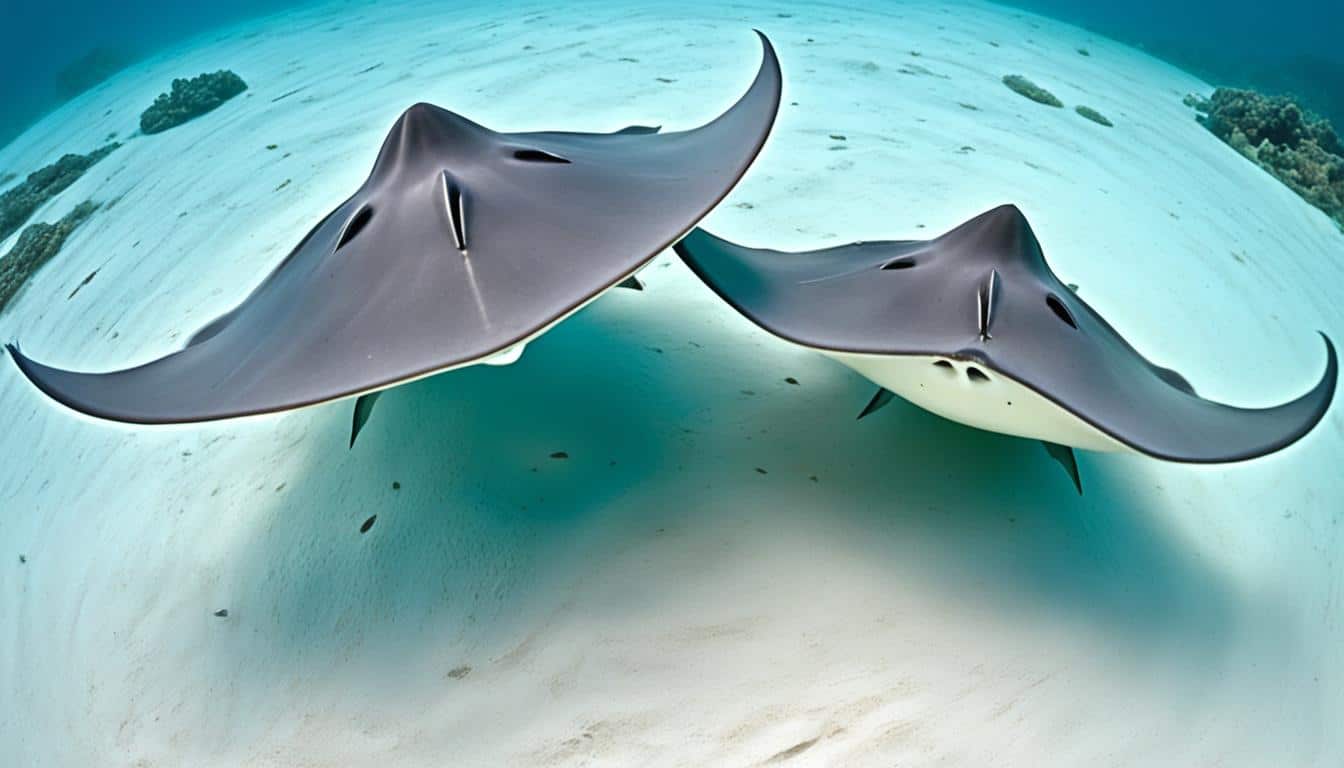Ever curious about how stingrays reproduce? These fascinating creatures, linked to sharks, have a unique stingray reproductive process. They have special mating behaviors and care for their young, making them stand out in the sea. Let’s explore the stingray reproduction cycle and see how they bring new life to the ocean.
Overview of Stingray Biology
Stingrays are part of the phylum Chordata and class Chondrichthyes. They stand out with their unique biology. Their flat bodies help them hide in the sand of warm and temperate waters. This lets them compete well in their home.
Stingrays are known for their venomous tail barb. This barb helps protect them from predators. They live about 15 to 25 years and eat mollusks, crustaceans, and small fish. This shows they are meat-eaters.
Stingrays usually swim alone but change their ways during breeding season. They show interesting social behaviors then. Learning about their breeding helps scientists understand their life and behavior better.
Stingray Reproductive Process
The way stingrays reproduce is quite interesting and shows their unique biology. They are ovoviviparous, which means they have live young instead of laying eggs. This method helps the babies have a better chance of surviving in the water.
When it’s mating season, male stingrays show special behaviors. They follow and gently bite the pectoral fins of females. This is the start of a more intimate process. Then, the male uses claspers, which are part of their pelvic fins, to move sperm into the female.
After mating, the female stingray is pregnant for about three to four months. The babies get food from a yolk sac during this time. A female stingray can have between five to thirteen babies, depending on the species and the environment.
This unique way of reproducing is key to keeping stingray populations healthy. Knowing how they breed helps us protect these amazing creatures and their homes in the ocean.
How do stingrays reproduce?
Stingray reproduction is quite fascinating. Their mating behavior and breeding habits are unique. These traits affect their reproductive cycle and genetic diversity.
Stingray Mating Behavior
Male stingrays show special behaviors to attract females during mating season. They follow potential mates closely until they start courtship. Males then bite gently at the females’ fins to show they’re ready to mate.
This can go on for hours as males compete to win a mate.
Stingray Breeding Habits
Stingrays often mate with multiple males, which helps increase genetic diversity in their young. This is important for survival in a changing environment. The timing of mating is crucial.
Things like water temperature and food availability affect the size and health of the babies. Mating in the best conditions leads to healthier offspring.
| Mating Behavior | Breeding Habit | Reproductive Cycle |
|---|---|---|
| Male tracking of females | Multiple matings by females | Varies with water temperature |
| Gentle biting to show interest | Genetic diversity for resilience | Influenced by food availability |
| Extended courtship phases | Timing affects litter health | Seasonal variations in mating |
Stingray Sexual Maturity and Gestation Period
Understanding how stingrays grow to maturity and their gestation period is key to learning about their reproduction. Most stingray species become ready to reproduce between ages 3 to 4. This is a crucial time in their life cycle, as they can now mate and help grow the population.
Age of Sexual Maturity
When stingrays reach stingray sexual maturity, they are ready to have babies. Many things affect when they mature, like their species, their environment, and the resources they have. Some stingrays mature a bit earlier or later, making this age a key sign of their health and growth.
Typical Gestation Duration
After mating, the female stingray carries her babies for about three to four months. At first, the babies get their nutrients from a yolk sac. Later, they start getting uterine milk, which is very important for their growth. Knowing how long the gestation lasts helps us protect these creatures during their breeding season.

| Aspect | Details |
|---|---|
| Age of Sexual Maturity | 3 to 4 years |
| Typical Gestation Duration | 3 to 4 months |
| Embryonic Development | Yolk sac and uterine milk |
Stingray Offspring Development
Learning about how stingray babies grow is key to understanding their complex birth process. Their early growth depends a lot on the food they get from their mom. This support is crucial for giving them a strong start in their underwater world.
Nutritional Support from the Mother
The mother stingray starts feeding her babies even before they are born. She gives them uterine milk full of nutrients. This helps the babies grow strong and healthy right from the start.
Initial Size and Self-Sufficiency of Young Stingrays
When stingray babies are born, they are very small, about three inches wide. But they can take care of themselves almost immediately. They are helped by the food they got from their mom before birth. Some stingrays, like the giant freshwater stingray, get extra care from their mom, making them stronger and better prepared for their environment.
Impact of Environmental Factors on Stingray Reproduction
Understanding how environmental factors affect stingray reproduction is key to their survival. Habitat availability is crucial for their mating and success. When they have plenty of suitable places to live, stingrays mate more and produce more offspring.
Water temperature also plays a big role in stingray reproduction. Most stingrays like warmer waters for mating. Even small changes in temperature can mess with their breeding cycles. Climate change is making things harder by changing water temperatures and destroying their homes. This can lead to fewer stingrays and smaller populations.
Overfishing and losing habitats are big threats to marine life. If these issues keep up, they’ll hit stingray reproduction hard. We need good conservation plans to help them. Watching these issues closely is important for the future of stingrays, many of which are already in danger.
FAQ
How do stingrays reproduce?
Stingrays have a unique way of reproducing called ovoviviparity. They give birth to live young. Males court females, and successful mating involves sperm transfer using claspers. After three to four months of gestation, females give birth to 5 to 13 young.
What are the typical mating behaviors of stingrays?
Male stingrays start courtship by tracking and gently biting the pectoral fins of females. This often leads to females mating with multiple males. This increases genetic diversity in their offspring.
When do stingrays reach sexual maturity?
Stingrays usually become sexually mature between 3 to 4 years old. This is a key phase in their reproductive cycle.
How long is the gestation period for stingrays?
Stingrays are pregnant for about three to four months. During this time, embryos develop and get nourishment from a yolk sac and later from uterine milk.
What is the initial size of baby stingrays at birth?
At birth, baby stingrays are less than three inches wide. They are often self-sufficient and can thrive on their own soon after entering the water.
How do environmental factors impact stingray reproduction?
Environmental factors like habitat availability, water temperature, and climate changes affect stingray mating and success. Overfishing and habitat loss also threaten their populations.
What kind of nutritional support do mother stingrays provide to their young?
Mother stingrays provide essential nutrients to their embryos through uterine milk during gestation. This helps the young gain strength and have a survival advantage after birth.







